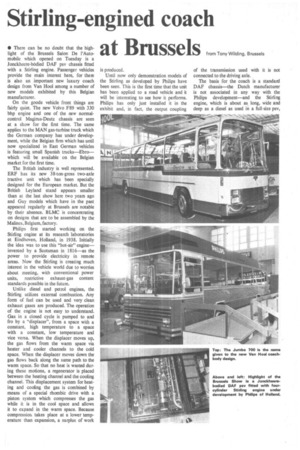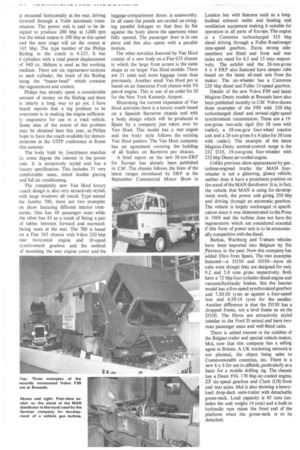Stirling-engined coach
Page 31

Page 32

If you've noticed an error in this article please click here to report it so we can fix it.
at Brussels from Tony Wilding, Brussels
• There can be no doubt that the highlight of the Brussels Salon De l'Automobile which opened on Tuesday is a Jonckheere-bOdied DAF psv chassis fitted with a Stirling engine. Passenger vehicles provide the main interest here, for there is also an important new luxury coach design from Van Hool among a number of new models exhibited by this Belgian manufacturer.
On the goods vehicle front things are fairly quiet. The new Volvo F89 with 330 bhp engine and one of the new normalcontrol Magirus-Deutz chassis are seen at a show for the first time. The same applies to the MAN gas-turbine truck which the German company has under development, while the Belgian firm which has until now specialized in East German vehicles is featuring small Spanish trucks—Ebrowhich will be available on the Belgian market for the first time.
The British industry is well represented. ERF has its new 38-ton-gross two-axle tractive unit which has been specially designed for the European market. But the British Leyland stand appears smaller than at the last show here two years ago and Guy models which have in the past appeared regularly at Brussels are notable by their absence. BLMC is concentrating on designs that are to be assembled by the Malines, Belgium, factory.
Philips first started working on the Stirling engine at its research laboratories at Eindhoven, Holland, in 1938. Initially the idea was to use this "hot-air" engine— invented by a Scotsman in 1816—as the power to provide electricity in remote areas. Now the Stirling is creating much interest in the vehicle world due to worries about meeting, with conventional power units, restrictive exhaust-gas content standards possible in the future.
Unlike diesel and petrol engines, the Stirling utilizes external combustion. Any form of fuel can be used and very clean exhaust gases are produced. The operation of the engine is not easy to understand. Gas in a closed cycle is pumped to and fro by a "displacer", from a space with a constant, high temperature to a space with a constant, low temperature and vice versa. When the displacer moves up, the gas flows from the warm space via heater and cooler channels to the cold space. When the displacer moves down the gas flows back along the same path to the warm space. So that no heat is wasted during these motions, a regenerator is placed between the heating channel and the cooling channel. This displacement system for heating and cooling the gas is combined by means of a special rhombic drive with a piston system which compresses the gas while it is in the cool space and allows it to expand in the warm space. Because compression takes place at a lower temperature than expansion, a surplus of work is produced.
Until now only demonstration models of the Stirling as developed by Philips have been seen. This is the first time that the unit has been applied to a road vehicle and it will be interesting to see how it performs. Philips has only just installed it in the exhibit and, in fact, the output coupling of the transmission used with it is not connected to the driving axle.
The basis for the coach is a standard DAF chassis—the Dutch manufacturer is not associated in any way with the Philips development—and the Stirling engine, which is about as long, wide and deep as a diesel as used in a full-size psv,
is mounted horizontally at the rear, driving forward through a Voith automatic transmission. The power unit is said to be designed to produce 200 bhp at 3,000 rpm but the initial output is 100 bhp at this speed and the next stage will set the output at 165 bhp. The type number of the Philips Stirling in the coach is 4-235. It has 4 cylinders with a total piston displacement of 940 cc. Helium is used as the working medium. There are six regenerator sections to each cylinder, the heart of the Stirling being the "heater-head" which contains the regenerators and coolers.
Philips has already spent a considerable amount of money on the Stirling and there is clearly a long way to go yet. I have heard reports that a big problem to be overcome is in making the engine sufficiently responsive for use in a road vehicle. Some idea of the extent of this problem may be obtained later this year, as Philips hope to have the coach available for demonstrations at the UITP conference in Rome this summer.
The body built by Jonckheere matches to some degree the interest in the power unit. It is attractively styled and has a luxury specification. This includes 31 very comfortable seats, tinted double glazing and full air conditioning.
The completely new Van Hool luxury coach design is also very attractively styled, with large windows all round. Type named the Jumbo 700, there are two examples on show featuring different interior treatments. One has 48 passenger seats while the other has 45 as a result of fitting a pair of tables between forward and rearwardfacing seats at the rear. The 700 is based on a Fiat 343 chassis with 9-litre 220 bhp rear horizontal engine and 10-speed synchromesh gearbox and the method of mounting the rear engine cover and the luggage-compartment doors is noteworthy. In all cases the panels are carried on swinging parallel linkages so that they lie fiat against the body above the apertures when fully opened. The passenger door is in one piece and this also opens with a parallel motion.
The other novelties featured by Van Hoot consist of a new body on a Fiat 625 chassis in which the large front screen is the same shape as on larger Van Hool models. There are 21 seats and more luggage room than previously. Another small Van Hool psv is based on an American Ford chassis with V8 petrol engine. This is one of an order for 30 for the New York Kennedy Airport.
Illustrating the current expansion of Van Hool activities there is a luxury coach based on a Spanish Barreiros chassis and with a body design which will be produced in Spain by a company just taken over by Van Hool. This model has a rear engine and the body style follows the existing Van Hool pattern. The Van Hool company has an agreement covering the building of all bodies on Barreiros psv chassis.
A brief report on the new 38-ton-ERF for Europe has already been published in CM. The chassis follows the lines of the latest ranges introduced by ERF at the September Commercial Motor Show in
London but with features such as a longitudinal exhaust outlet and heating and ventilation equipment making it suitable for operation in all parts of Europe. The engine is a Cummins turbocharged 335 bhp diesel driving through a Fuller Roadranger nine-speed gearbox. Extra strong sidemembers are fitted and front and rear axles are rated for 6.5 and 13 tons respectively. The exhibit and the 26-ton-gross 6 x 4 ERF also featured have sleeper cabs based on the latest all-steel unit from the maker. The six-wheeler has a Cummins 220 bhp diesel and Fuller 15-speed gearbox.
Details of the new Volvo F89 and latest Magirus-Deutz models at Brussels have also been published recently in CM. Volvo shows three examples of the F89 with 330 bhp turbocharged diesel and revised eight-speed synchromesh transmission. These are a 19ton-gross two-axle rigid (for 38 tons with trailer), a 38-ton-gcw four-wheel tractive unit and a 26-ton-gross 6 x 4 (also for 38 tons with trailer). The example of the latest Magirus-Deutz normal-control range is the 232 D19, 19-ton-gross four-wheeler with 232 bhp Deutz air-cooled engine.
Unlike previous show appearances by gas-. turbine-engined trucks the MAN fourwheeler is not a glittering, glossy vehicle, neither does it have a prominent position on the stand of the MAN distributor. It is, in fact, the vehicle that MAN is using for development work, the power unit giving 350 bhp and driving through an automatic gearbox. The vehicle is largely unchanged in specification since it was demonstrated to the Press in 1969 and the turbine does not have the regenerators which are considered essential if this form of power unit is to be economically competitive with the diesel.
Barkas, Wartburg and Trabant vehicles have been imported into Belgium by Ets ,Pierreux in the past. Now this company has added Ebro from Spain. The two examples featured—a D550 and D350—have tat cabs even though they are designed for only 9.2 and 5.8 tons gross respectively. Both have a 72 bhp four-cylinder diesel engine and vacuum/hydraulic brakes. But the heavier model has a five-speed synchronized gearbox and 7.50-20 tyres as against a four-speed box and 6.50-16 tyres for the smaller. Another difference is that the D550 has a dropped frame, not a level frame as on the D350. The Ebros are attractively styled (similar to the Ford D series) and have twoman passenger seats and well-fitted cabs.
There is added interest in the exhibits of the Belgian trailer and special vehicle maker, Mol, now that this company has a selling agent in Britain. A UK marketing network is not planned, the object being sales to Commonwealth countries, etc. There is a new 6 x 6 for use in oilfields, particularly as a basis for a mobile drilling rig. The chassis has a Deutz F6L 170 bhp air-cooled engine, ZF six-speed gearbox and Clark (US) front and rear axles. Mol is also showing a heavyload drop-deck semi-trailer with detachable goose-neck. Load capacity is 45 tons (unladen the unit weighs 14 tons) and a built-in hydraulic ram raises the front end of the platform when the goose-neck is to be detached.




































































































